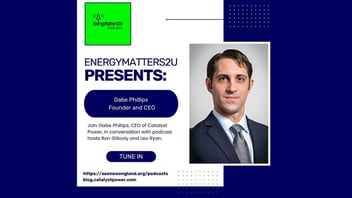The Solar Maverick Podcast Featuring Catalyst Power CEO Gabe Phillips

Benoy Thanjan sat down with Catalyst Power CEO Gabe Phillips on the podcast to explore the changing landscape of commercial and industrial clean energy. Gabe shared insights from his journey in the energy sector and detailed Catalyst Power’s tailored approach for mid-sized businesses—including creative uses of solar, energy storage, and cogeneration to help C&I customers save costs and unlock new value. The conversation delved into the unique niche Catalyst Power serves, the growing importance of distributed energy resources and aggregation, and how tech-enabled platforms support customer acquisition in dynamic markets. They also discussed what’s next for C&I energy solutions as federal and state incentives continue to evolve.
You can listen to the full episode by clicking the link here.
The interview below has been edited for brevity.
Unpacking Local Law 97 in New York:
Part of the [Local Law 97] story I want to tell requires us to unpack what VDER is in New York for a quick sec.
VDER is the value of distributed energy resources, and it's the credit that you get that you create when you make a kilowatt hour of community solar production anywhere in the state. And it's different in every utility territory because one component of it is the wholesale power price, the LMP in that market.
So, you actually have wholesale power markets exposure as a community solar asset owner in the state of New York. That's one thing that's worth noting. The other piece of it is demand reduction value. There's a capacity market component to that. And then there's the e-value, the environmental attribute…that you are disaggregating and selling to your interconnecting utility.
So, if I were to build a small community solar project on a building in Staten Island in New York City, I have now, in order to elect to take the e-value to maximize VDER for myself, I am now conveying the environmental attributes to ConEd. So that would mean, hypothetically, that a subscriber to that community solar array is simply a bill credit recipient. They are not a renewable energy bill credit recipient. Because the aspect of that kilowatt hour that was renewable was sold to ConEd. It's not available to the customer any longer. But Local Law 97 explicitly permitted remote solar to contribute to a customer's reduction in their carbon intensity, which is the main thrust of that law. The carbon score, if you don't reduce it, penalties are assessed.
On cogeneration reducing carbon intensity:
Other things that you can do to reduce carbon intensity would be boiler change outs. Right? You've got a dirtier boiler that's inefficient. It's on oil. You can switch to natural gas. That can be expensive sometimes. You could switch to cogeneration, which is even better from a thermal efficiency perspective. And so we figured, you know, we shouldn't be a solar-only developer alongside our retail business and community solar aggregation business. We should add something extra complicated to the mix.
We started a partnership in cogeneration, specifically in New York and New Jersey first [with] a partner called OHA Power. So, we have a joint venture with them, then they're the experts. They're the boiler room guys. And they serve up these opportunities for us fully engineered, which is key because these are, like, bespoke designs that are tied into HVAC systems.
Advice for entrepreneurs in the energy sector:
I think that diversification of a business, not just in energy, but any entrepreneurial venture that you're taking on, is really important. You’ve got to think about what could change in the landscape of the market that you're trying to focus on, and how will you make it when that change happens.
Enjoyed the conversation? Contact our Energy Experts today to learn how you can partner with Catalyst Power on cogeneration or other energy efficient solutions for your business.

.jpg?width=352&name=Untitled%20design%20(9).jpg)

